Ditapis dengan
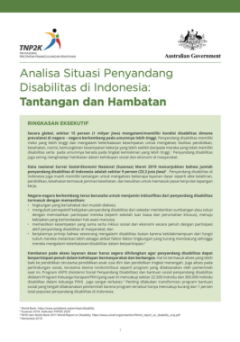
Analisa Situasi Penyandang Disabilitas di Indonesia: Tantangan dan Hambatan
Penyandang disabilitas di Indonesia tidak hanya menghadapi risiko ekonomi dan finansial yang besar, tetapi juga menghadapi tantangan besar dalam mengakses fasilitas dan layanan kesehatan serta pendidikan, perlindungan sosial dan memasuki pasar tenaga kerja. Sejak tahun 2018, Survei Sosial Ekonomi Nasional (Susenas) telah secara konsisten memasukkan Pertanyaan Disabilitas Kelompok Washington5 ya…
- Edisi
- 1
- ISBN/ISSN
- -
- Deskripsi Fisik
- PDF, 16 Halaman
- Judul Seri
- Policy Brief
- No. Panggil
- 371.9 SIY.A
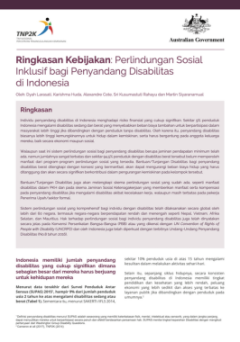
Ringkasan Kebijakan: Perlindungan Sosial Inklusif bagi Penyandang Disabilita…
Individu penyandang disabilitas di Indonesia menghadapi risiko finansial yang cukup signifikan. Sekitar 9% penduduk Indonesia mengalami disabilitas sedang dan berat yang menyebabkan beban biaya tambahan untuk berpartisipasi dalam masyarakat lebih tinggi jika dibandingkan dengan penduduk tanpa disabilitas. Oleh karena itu, penyandang disabilitas biasanya lebih tinggi kemungkinannya untuk hidup d…
- Edisi
- 1
- ISBN/ISSN
- -
- Deskripsi Fisik
- PDF, 8 Halaman
- Judul Seri
- Policy Brief
- No. Panggil
- 371.9
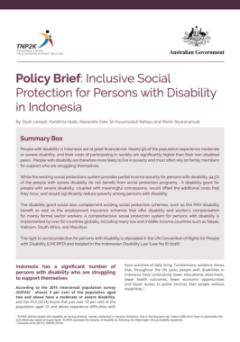
Policy Brief: Inclusive Social Protection for Persons with Disability in In…
According to the 2015 intercensal population survey (SUPAS)1 almost 9 per cent of the population aged two and above have a moderate or severe disability, and the IFLS (2014) found that just over 10 per cent of the population aged 15 and above experience difficulties with basic activities of daily living. Furthermore, evidence shows that, throughout the life cycle, people with disabilities in In…
- Edisi
- 1
- ISBN/ISSN
- -
- Deskripsi Fisik
- PDF, 8 Halaman
- Judul Seri
- Policy Brief
- No. Panggil
- 371.9 LAR.P

Disability Situation Analysis Challenges and Barriers for People with Disabi…
People with disability in Indonesia are not only at great economic and financial risk but are also facing great challenges in accessing health and education facilities and services, social protection, and in entering the labour market. In 2018, the Indonesia National Socio-Economic Survey (Susenas) included the Washington Group Disability Questions Set5 which aims to provide the most updated in…
- Edisi
- 1
- ISBN/ISSN
- -
- Deskripsi Fisik
- PDF, 16 Halaman
- Judul Seri
- Policy Brief
- No. Panggil
- 371.9 SIY.D
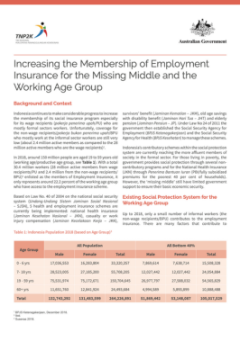
Increasing the Membership of Employment Insurance for the Missing Middle and …
Indonesia continues to make considerable progress to increase the membership of its social insurance program especially for its wage recipients (pekerja penerima upah/PU) who are mostly formal sectors workers. Unfortunately, coverage for the non-wage recipients/pekerja bukan penerima upah/BPU who mostly work at the informal sector workers are still very low (about 2.4 million active members as …
- Edisi
- 1
- ISBN/ISSN
- -
- Deskripsi Fisik
- PDF, 2 Halaman
- Judul Seri
- Policy Brief
- No. Panggil
- 368.4 LAR.I

Meningkatkan Kepesertaan Program Jaminan Sosial Ketenagakerjaan bagi Kelompok…
Indonesia mencatat kemajuan pesat dalam meningkatkan kepesertaan program jaminan sosial ketenagakerjaan, khususnya untuk pekerja penerima upah (PPU) yang biasanya adalah pekerja sektor formal. Sayangnya, kepesertaan pekerja bukan penerima upah (BPU) yang kebanyakan merupakan pekerja sektor informal, masih sangat rendah— baru sekitar 2,4 juta anggota aktif jika dibandingkan dengan 28 juta angg…
- Edisi
- 1
- ISBN/ISSN
- -
- Deskripsi Fisik
- PDF, 2 Halaman
- Judul Seri
- Policy Brief
- No. Panggil
- 368.4 LAR.M
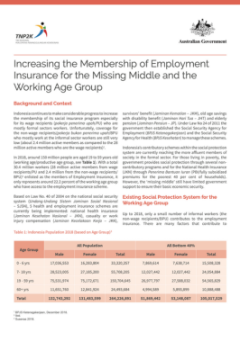
Increasing the Membership of Employment Insurance for the Missing Middle and …
Indonesia continues to make considerable progress to increase the membership of its social insurance program especially for its wage recipients (pekerja penerima upah/PU) who are mostly formal sectors workers. Unfortunately, coverage for the non-wage recipients/pekerja bukan penerima upah/BPU who mostly work at the informal sector workers are still very low (about 2.4 million active members as …
- Edisi
- 1
- ISBN/ISSN
- -
- Deskripsi Fisik
- PDF, 2 Halaman
- Judul Seri
- Policy Brief
- No. Panggil
- 363.3 LAR.I
 Karya Umum
Karya Umum  Filsafat
Filsafat  Agama
Agama  Ilmu-ilmu Sosial
Ilmu-ilmu Sosial  Bahasa
Bahasa  Ilmu-ilmu Murni
Ilmu-ilmu Murni  Ilmu-ilmu Terapan
Ilmu-ilmu Terapan  Kesenian, Hiburan, dan Olahraga
Kesenian, Hiburan, dan Olahraga  Kesusastraan
Kesusastraan  Geografi dan Sejarah
Geografi dan Sejarah